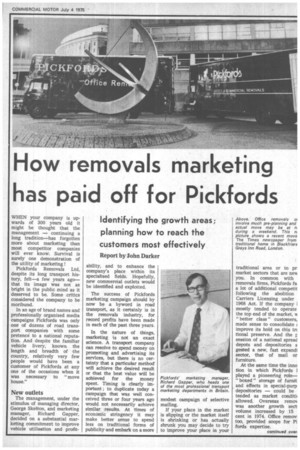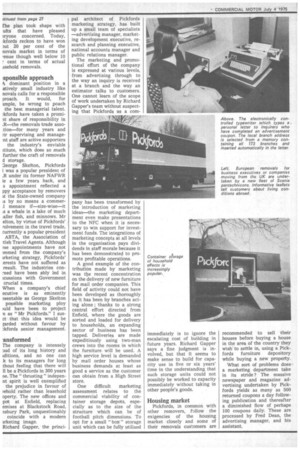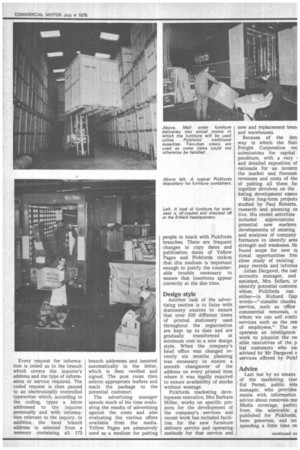How removals marketing has paid off for Pickfords
Page 29

Page 30

Page 31

If you've noticed an error in this article please click here to report it so we can fix it.
WHEN your company is upwards of 300 years old it might be thought that the management — continuing a long tradition—has forgotten more about marketing than most competitor companies will ever know. Survival is surely one demonstration of the utility of marketing !
Pickfords Removals Ltd, despite its long transport history, felt—a few years ago— that its image was not as bright in the public mind as it deserved to be. Some critics considered the company to be moribund.
In an age of brand names and professionally organised media campaigns Pickfords was only one of dozens of road transport companies with some pretence to a national reputation. And despite the familiar vehicle livery, known the length and breadth of the country, relatively very few people would have been a customer of Pickfords at any one of the occasions when it was necessary to "move house."
New outlets
The management, under the stimulus of managing director, George Skelton, and marketing manager, Richard Gapper, decided on a .substantial marketing commitment to improve vehicle utilisation and profit ability, and to enhance the company's place within its specialised fields. Hopefully, new commercial outlets would be identified and exploited.
The success of Pickfords marketing campaign should by now be a byword in road transport, as it certainly is in the removals industry, for record profits have been made in each of the past three years.
In the nature of things, marketing is not an exact science. A transport company can resolve to spend money on promoting and advertising its services, but there is no certainty that a particular method will achieve the desired result or that the best value will be achieved for the money spent. Timing is clearly important; to duplicate today a campaign that was well conceived three or four years ago would not necessarily achieve similar results. At times of economic stringency it may make better sense to spend less on traditional forms of publicity and embark on a more modeSt campaign of selective mailing.
If your place in the market is slipping or the market itself is shrinking or has actually Shrunk you may decide to try to improve your place in your traditional area or to pr market sectors that are nev, you. In common with removals firms, Pickfords fa a lot of additional competit following the abolition Carriers Licensing under 1968 Act. If the company 1 mostly tended to operate the top end of the market, IA " better class" customers, made sense to consolidate improve its hold on this tn tonal preserve. And the session of a national spread depots and depositories s gested a new, fast expandi sector, that of mail or furniture.
At the same time the inno Ilion in which Pickfords played a pioneering role" boxed " storage of furnit and effects in special-purp depositories — could be tended as market conditit allowed. Overseas rernoN, was another growth sect volume increased by 15 cent in 1974. Office remov. too, provided scope for Pi fords expertise. rhe plan took shape with ultS that have pleased aryone concerned. Today, :kfords reckon to have won mit 20 per cent of the novels market in terms of renue though well below 10 cent in terms of actual usehold removals.
,sponsible approach ta dominant position in a atively small industry like novals calls for a responsible proach. It would, for ample, be wrong to poach the best managerial talent. :kfords have taken a promiat share of responsibility in ,R—the removals trade asso.tion—for many years and !ir supervising and manage!nt staff are active supporters the industry's enviable ;Mute, which does so much further the craft of removals d storage.
aeorge Skelton, Pickfords was a popular president of ,R under its former NAFWR Le a few years back, and s appointment reflected a ppy acceptance by removers it the State-owned company s by no means a commer.1 menace if—size-wise—it .s a whale in a lake of much .aller fish, and minnows. Mr elton, by virtue of Pickfords' rolvement in the travel trade, currently a popular president ABTA, the Association of tish Travel Agents. Although ?.se appointments have not mimed from the company's irketing strategy, Pickfords' .erests have not suffered as result. The industries conriled have been ably led in ;missions with Government crucial times.
When a company's chief ecutive is as eminently asentable as George Skelton possible marketing ploy )uld have been to project n as "Mr Pickfords." I suset that this idea would be larded without favour by kfords senior management.
ansformed
The company is intensely aud of its long history and tclitions, and no one can k to its managers for long thout feeling that there will 11 be a Pickfords in 300 years rte. The " thrusting " indepennt spirit is well exemplified the prejudice in favour of :ehold rather than leasehold operty. The new offices and pot at Enfield, replacing emises at BIackstock Road, asbury Park, unquestionably coincide with a modern arketing image.
Richard Gapper, the princi pal architect of Pickfords marketing strategy, has built up a small team of specialists —advertising manager, marketing development executive, research and planning executive, national accounts manager and public relations manager.
The marketing and promotional effort of the company is expressed at various levels, from advertising through to the way an inquiry is received at a branch and the way an estimator talks to customers. One cannot learn of the scope of work undertaken by Richard Gapper's team without suspecting that Pickfords as a com pany has been transformed by the introduction of marketing ideas—the marketing department even make presentations to the NFC when it is necessary to win support for investment funds. The integrations of marketing concepts at all levels in the organisation pays dividends in staff morale because it has been demonstrated to promote profitable operations.
A good example of the contribution made by marketing was tbe recent concentration on the delivery of new furniture for mail order companies. This field of activity could not have been developed as thoroughly as it has been by branches acting alone ; 'thanks to a strong central effort directed from Enfield, where the goods are sorted and loaded for delivery to households, an expanding sector of business has been tapped. Deliveries •are made expeditiously using two-man crews into the rooms in which the furniture will be used. A high service level is demanded by mail order houses whose business demands at least as good a service as the customer can obtain from a High Street store.
One difficult marketing assessment relates to the commercial viability of container storage depots, especially as to the size of the structure which can be of football pitch dimensions. To opt for a small "box" storage unit which can be fully utilised immediately is to ignore the escalating cost of building in future years. Richard Gapper says a fine judgment is involved, but that it seems to make sense to build for capacity use in five or six years' time in the understanding that such storage units could not possibly be worked 'to capacity immediately without taking in other people's goods.
Housing market
Pickfords, in common with other removers, follow the exigencies of the housing market closely and some of their removals customers are recommended to sell their houses before buying a house in the area of the country they wish to settle in, using a Pickfords furniture depository while buying a new property.
What sort of problems doesa marketing department take in its stride ? The massive newspaper and magazine advertising undertaken by Pickfords yields as many as 500 returned coupons a day following publication and thereafter a diminished flow of perhaps 100 coupons daily. These are processed by Fred Dean, the advertising manager, and his assistant; Every request for information is coded as to the branch which covers the inquirer's address and the type of information or service required. The coded request is then passed to an electronically controlled typewriter which, according to the coding, types a letter addressed to the inquirer personally and with information relevant to the inquiry. In addition, the local branch address is selected from a memory containing all 173 branch addresses and inserted automatically in the letter, which is then verified and signed. The post room then selects appropriate leaflets and mails the package to the pOtential customer.
The advertising manager spends much of his time evaluating the results of advertising against the costs and also evaluating the various offers available from the media. Yellow Pages are extensively used as a medium for putting people in touch with Pickfords branches. There are frequent changes in copy dates and publication dates of Yellow Pages and Pickfords reckon that this medium is important enough to justify the considerable trouble necessary to ensure that insertions appear correctly at the due time.
Another task of the advertising section is to liaise with stationery sources to ensure that •over 200 different items of printed stationery used throughout the organisation are kept up to date and •are gradually transformed at minimum cost to a new design style. When 'the company's head office was changed recently six months planning was necessary •to ensure a smooth changeover of the address on every printed item where it was legally required to ensure availability of stocks without wastage.
Pickfords marketing development executive, Mrs Barbara Miller, works on specific projects for the development of the company's services and recent work has included facilities for the new furniture delivery service and operating methods for that service and new and replacement bran and warehouses.
Because of the detq way in which the Nati Freight Corporation rec submissions for capital penditure, with a very and detailed exposition of rationale for an investn the market and forecast! revenues and costs of the of putting all these fac together devolves on the : keting development execu More long-term projects Studied by Paul Roberts, research and planning ex tive. His recent activities included appreciations potential new markets developments of existing and analyses of company formance to identify area strength and weakness. HE found scope for new cri tional opportunities fror close study of existing pany records and informa Julian Dargavel, the nat accounts manager, and assistant, Mrs Sellars, tr identify potential custame whom Pickfords can either—in Richard Gap words—" sizeable chunks service, such as office commereial removals, o: whom we can sell contir services such as the ren of employees." The se operates an intelligence work to pinpoint the re sible executives of the p dal customers who ex advised by Mr Dargavel o services offered by Pickf
Advice




















































































